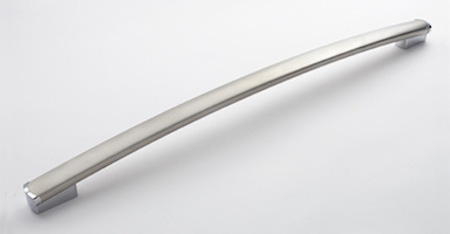As with any product development process, moving an appliance handle design from concept to production requires compromises. No matter how elegant the idea, if a handle design can’t be manufactured at an acceptable cost, it’s never going to see the showroom floor.
Designers hate seeing their concepts altered as they make their way to the shop floor but changes are minimized when designers partner with process specialists. Expertise in sheet metal manufacturing, combined with a willingness to push the boundaries of what’s possible, ensures design realization will be as close to the intent as possible.
In the competitive appliance industry, speed to market is a priority. Rather than design, then modify an appliance handle design for production, the quicker route is to design for manufacture in the first place. What follows is a discussion of appliance handle material characteristics and a list of essential manufacturing considerations that should be taken into account if you want to make your handle design process as efficient as possible.
Material Considerations for Appliance Handle Design
While demand for stainless steel handles in the appliance industry remains strong, it’s not the only material used for appliance handle manufacturing. Castings, carbon steels, and other metals are all candidates. Stainless has some particularly challenging characteristics, but most of the design-manufacturability issues are common across all sheet metal.
The number one challenge with stainless, especially the popular 304 grade, is work hardening during forming. This happens as austenite in the metallic structure turns to martensite, increasing hardness and reducing ductility. Unless processes are designed and controlled appropriately, cracking usually results.
A second challenge is welding. Stainless has a relatively high coefficient of thermal expansion, but also low conductivity. Distortion is likely unless careful attention is paid to how components are fixtured.
Lastly, stainless, like other sheet materials, has a grain running parallel to the rolling direction. Just like with the grain in wood, metal is prone to cracking when bent along the grain. How the blank is oriented in the sheet or strip will strongly influence material utilization.
Here are some general tips when it comes to material characteristics that should be taken into account during the handle design process:
- Material properties. Anticipate both work hardening and springback during forming. Minimize the amount of forming needed. Determine the orientation of the grain as it will influence where to put folds and how the blank comes out of the sheet (unless using a continuous roll forming process).
- Dissimilar materials. Galvanic corrosion is always a possibility when different materials are placed in contact, especially if moisture is likely. Design accordingly.
Processes Considerations for Appliance Handle Design
Every manufacturing process has a yield. Material is discarded when parts are stamped from sheet, mostly while setting up for and during forming, particularly when the material has a propensity to harden. With a high-cost material like stainless, such losses can drive up individual piece cost and strongly influence process selection.
Process speed, set-up time, and batch size are other factors. Some processes run slower but are quick to set up (although they may also produce more scrap). Welding, in particular, is often both slow and expensive, although it can be automated when volumes warrant.
Assembly costs are reduced by minimizing piece count. The tradeoff is that fewer, more complex components may need more sophisticated processes like hydroforming.
In summary, here are some points for engineers to attend to as they put together an appliance handle design:
- Welding minimization. Welding is expensive and introduces variability. Plus welds need finishing operations like grinding and polishing. Look for ways — such as tube hydroforming — to form the assembly from a single piece.
- Bend radii. When designing a bend in a tube, the centerline radius should be at least double the tube diameter.
- Sheet metal bends. The inside radius of the bend should always exceed the material thickness.
- Forming folds and bends. Folds, which have a tight radius, are usually made on a folder. A press brake is used for larger radius bends. The design must leave space to get the press brake tool in and for the metal to move up. Consider the sequence when designing multiple bends into a single blank.
- Holes. Don’t put these near edges or bends as they will distort. Keep the hole edge at least the material thickness away from these features. Holes should be spaced with at least the hole radius between each one. Hole diameters should be at least 1.5 times material thickness to avoid excessively high tool loads, sheet distortion, and large burrs.
- Secondary deformation operations. It’s best to do all the deformation at once. If a subsequent deformation is needed, the material will have to go through a slow and expensive annealing process.
How to Make Appliance Handle Designs Suited for Manufacturing
Appliance handle design dictates the manufacturing processes needed and, in turn, the final piece cost.
At Mills Products, we’re a contract manufacturer specialized in appliance handle manufacturing that “speaks design.”
We can often propose design modifications to existing designs that will simplify manufacturing, but making these changes takes time. That’s why we recommend designers involve us early and often in the design process since designing for manufacturing from the outset will save both money and time, helping appliance manufacturers become more competitive and even win additional business.
To learn more about how Mills Products can have a positive effect on the appliance handle design process, download this appliance handle case study. Or, contact us to discuss the needs of your particular project.


